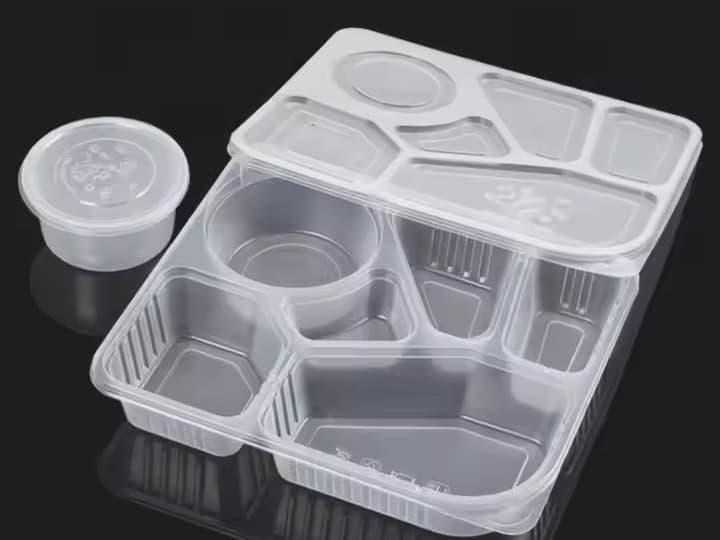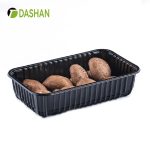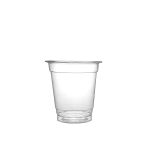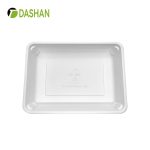Introduction
In today’s fast-paced foodservice and retail industry, packaging plays a vital role in ensuring food safety, convenience, and presentation. Among the many packaging solutions available, polypropylene (PP) multi-compartment food containers have gained widespread popularity. These containers, designed with multiple sections, allow food items to be stored separately while maintaining freshness and preventing cross-contamination.
From quick-service restaurants and school cafeterias to hospital meal delivery and household use, PP multi-compartment containers are everywhere. Their durability, heat resistance, microwave safety, and cost-effectiveness make them an excellent choice for both businesses and consumers. In this article, we will explore the diverse applications of PP multi-compartment food containers, their advantages, and how they are shaping the future of the global food packaging market.
What Are PP Multi-Compartment Food Containers?
PP multi-compartment containers are food packaging solutions made from polypropylene plastic. Unlike single-compartment containers, these boxes are divided into two, three, or more sections to separate different food items.
Key characteristics of PP containers include:
-
Material: Made from polypropylene, a lightweight, durable, and recyclable thermoplastic.
-
Heat Resistance: Safe for microwave heating and withstands temperatures up to 120°C.
-
Cold Resistance: Suitable for refrigeration and freezing without cracking.
-
Leak-Proof Design: Secure lids prevent spillage and keep sauces or liquids separate.
-
Versatile Sizes and Shapes: Available in multiple layouts, including 2-compartment, 3-compartment, and 5-compartment trays.

Applications of PP Multi-Compartment Food Containers
1. Restaurant and Takeaway Meals
One of the most significant applications of PP multi-compartment containers is in quick-service restaurants (QSRs), takeout services, and delivery platforms. With the rise of online food ordering, ensuring that meals arrive fresh and intact is crucial.
-
Bento boxes: Japanese-style meals often consist of rice, protein, and vegetables, which require separate sections.
-
Fast food combos: Burgers, fries, and salads can be packaged together without mixing flavors.
-
Meal prep services: Health-focused delivery businesses use PP containers to portion meals for weekly plans.
The compartments prevent sauces or oily foods from spilling into dry items, improving the overall dining experience.
2. Corporate and School Canteens
Canteens in offices, factories, and schools rely on PP multi-compartment containers for daily meal distribution.
-
Balanced diet packaging: Proteins, vegetables, and carbohydrates can be separated into different sections.
-
Child-friendly meals: Kids’ lunches often include a mix of fruits, snacks, and main dishes, which require organized storage.
-
Portion control: Helps institutions manage food costs and promote healthier eating.
Reusable PP trays are also common in these settings, as they can be washed and reused multiple times.
3. Hospital and Healthcare Meals
Nutrition plays a critical role in patient recovery, and hospitals often require strict portioning and separation of food. PP containers are ideal because:
-
They keep therapeutic diets separate and intact.
-
They allow for hot food service as the containers are microwave-safe.
-
They reduce contamination risk by sealing food tightly.
Multi-compartment trays also allow caregivers to label and customize meals for different patients efficiently.
4. Airline and Travel Catering
In the aviation and travel industry, where meals need to be prepared in advance and served under strict hygiene standards, PP containers are widely used.
-
Pre-packed airline meals: Breakfast, lunch, and dinner trays often include bread, main dishes, salads, and desserts in one container.
-
Railway and bus catering: Long-distance journeys require safe, portioned meals that remain fresh for hours.
-
Cruise ship catering: Buffet-style meals can be distributed in sealed trays for hygiene and convenience.
The stackable nature of PP containers also makes them easy to transport and store in bulk.
5. Supermarket Ready-to-Eat and Ready-to-Cook Meals
Modern consumers increasingly purchase ready-to-eat (RTE) and ready-to-cook (RTC) meals from supermarkets. PP containers are widely used for:
-
Salad boxes with dressing compartments
-
Pasta with separate sauce storage
-
Cold desserts and fruit platters
-
Frozen microwaveable meals
For supermarkets, multi-compartment PP packaging helps extend shelf life, prevent cross-contamination, and enhance the visual appeal of food displays.
6. Household Food Storage and Meal Prep
At the consumer level, PP multi-compartment boxes are a favorite for meal prepping and food storage.
-
Weekly meal organization: Fitness enthusiasts prepare meals in advance and store them in PP containers for convenience.
-
Leftover management: Different foods can be stored in one container without mixing.
-
Microwave and freezer compatibility: Perfect for reheating or storing leftovers.
Families also use multi-compartment trays for picnics and outdoor activities, as they keep snacks and meals fresh during travel.
7. Event Catering and Buffet Services
Large-scale catering companies often use PP multi-compartment containers for weddings, corporate events, and social gatherings.
-
Pre-portioned catering meals: Ensures fast distribution without compromising presentation.
-
Buffet takeaway options: Guests can carry multiple dishes in one secure tray.
-
Eco-conscious catering: Recyclable PP containers reduce waste compared to foam or mixed-material packaging.
This application has grown significantly with the popularity of grab-and-go catering services.
Advantages of PP Multi-Compartment Containers
-
Food Safety – Prevents cross-contamination and preserves flavors.
-
Convenience – Allows consumers to enjoy multiple dishes in one box.
-
Cost-Effective – Lightweight and affordable compared to alternatives.
-
Reusable Options – Can be washed and reused, reducing single-use waste.
-
Sustainable Choice – PP is recyclable and has a lower carbon footprint than polystyrene.
PP Containers vs. Other Materials
| Feature | PP Multi-Compartment | PET | PLA | Bagasse |
|---|---|---|---|---|
| Heat Resistance | Up to 120°C | Low | Moderate | Limited |
| Freezer Safe | Yes | Yes | No | Limited |
| Microwave Safe | Yes | No | Yes | No |
| Recyclable | Yes | Yes | Industrial only | Compostable |
| Cost | Low | Higher | Higher | Moderate |
This comparison shows why PP continues to dominate the market for multi-compartment food packaging.
Why Choose Xiamen Dashan for PP Multi-Compartment Containers
As a trusted manufacturer, Xiamen Dashan provides a full range of customizable PP food packaging solutions, including multi-compartment trays and lunch boxes.
-
High-quality PP material for safety and durability.
-
Flexible customization with various sizes, shapes, and compartments.
-
Global certifications ensuring compliance with international standards.
-
Sustainable practices with recyclable and eco-friendly packaging solutions.
-
Strong export capacity, serving foodservice and retail businesses worldwide.
Whether for restaurants, retailers, or large-scale catering, Dashan’s PP containers deliver performance, sustainability, and visual appeal.

Frequently Asked Questions (FAQs)
Q1: Are PP multi-compartment containers microwave safe?
Yes, PP containers can withstand high heat and are safe for microwave reheating.
Q2: Can they be used for freezing food?
Absolutely. PP remains stable at low temperatures, making it ideal for frozen meals.
Q3: Are PP containers recyclable?
Yes, PP (polypropylene) is recyclable under the resin identification code #5.
Q4: How many compartments are available?
Options range from 2 compartments up to 5 compartments, depending on application.
Q5: What industries use PP multi-compartment containers most?
They are widely used in restaurants, catering, healthcare, airlines, and retail supermarkets.
Conclusion
PP multi-compartment food containers have become an essential packaging solution across industries, from quick-service restaurants and hospital catering to household food storage. Their durability, cost-effectiveness, and compatibility with both hot and cold applications make them one of the most versatile packaging options available today.
As consumers continue to demand convenience, hygiene, and sustainability, PP containers will remain a key driver in the evolution of modern food packaging. With manufacturers like Xiamen Dashan, businesses can access innovative, customizable, and eco-conscious solutions that meet global market needs.
References
-
U.S. Food and Drug Administration (FDA) – Food Contact Materials
Link: https://www.fda.gov/food/packaging-food-contact-substances-fcs/food-contact-substances-inventory -
European Food Safety Authority (EFSA) – Safety of Polypropylene in Food Packaging
Link: https://www.efsa.europa.eu/en/topics/topic/food-contact-materials -
PlasticsEurope – Polypropylene (PP): Properties and Applications
Link: https://plasticseurope.org/sustainability/circularity/plastics-types/polypropylene/ -
Packaging Strategies – Foodservice Packaging Market Trends
Link: https://www.packagingstrategies.com/ -
Smithers – The Future of Global Foodservice Packaging to 2027
Link: https://www.smithers.com/services/market-reports/packaging/the-future-of-global-foodservice-packaging-to-2027 -
National Center for Biotechnology Information (NCBI) – Polypropylene in Food Packaging: Safety and Recycling
Link: https://www.ncbi.nlm.nih.gov/




